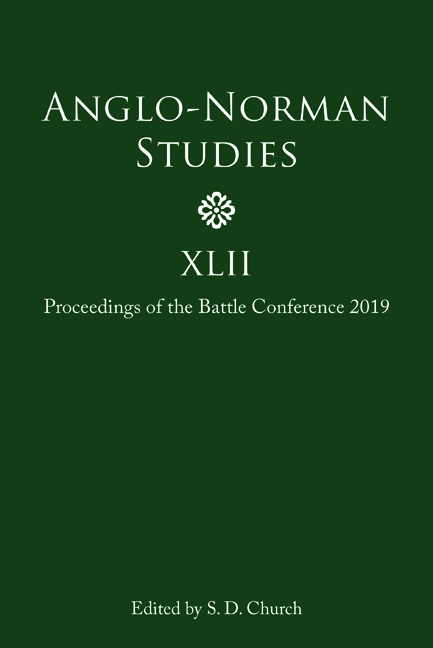Book contents
- Frontmatter
- Contents
- Illustrations and Tables
- Editor’s Preface
- Abbreviations
- Reassessing the Reign of King Æthelred the Unready: (The Allen Brown Memorial Lecture)
- The Art of Memory: The Posthumous Reputation of King Harold II Godwineson: (The Des Seal Memorial Lecture)
- Women, Memory and the Genesis of a Priory in Norman Monmouth
- The Sins of a Historian: Eadmer of Canterbury, Historia Novorum in Anglia, Books I–IV
- Angevin Rule in the West of Normandy, 1154–86: The View from Mont-Saint- Michel
- ‘A girly man like you can’t rule us real men any longer’: Sex, Violence and Masculinity in Dudo of Saint-Quentin’s Historia Normannorum
- Compiling Chronicles in Anglo-Norman Durham, c. 1100–30
- The Counts of Louvain and the Anglo-Norman World, c. 1100–c. 1215
- England, Normandy and the Ecclesiastical ‘New Law’ in the Later Twelfth Century
- Miscellaneous Endmatter
England, Normandy and the Ecclesiastical ‘New Law’ in the Later Twelfth Century
Published online by Cambridge University Press: 14 October 2020
- Frontmatter
- Contents
- Illustrations and Tables
- Editor’s Preface
- Abbreviations
- Reassessing the Reign of King Æthelred the Unready: (The Allen Brown Memorial Lecture)
- The Art of Memory: The Posthumous Reputation of King Harold II Godwineson: (The Des Seal Memorial Lecture)
- Women, Memory and the Genesis of a Priory in Norman Monmouth
- The Sins of a Historian: Eadmer of Canterbury, Historia Novorum in Anglia, Books I–IV
- Angevin Rule in the West of Normandy, 1154–86: The View from Mont-Saint- Michel
- ‘A girly man like you can’t rule us real men any longer’: Sex, Violence and Masculinity in Dudo of Saint-Quentin’s Historia Normannorum
- Compiling Chronicles in Anglo-Norman Durham, c. 1100–30
- The Counts of Louvain and the Anglo-Norman World, c. 1100–c. 1215
- England, Normandy and the Ecclesiastical ‘New Law’ in the Later Twelfth Century
- Miscellaneous Endmatter
Summary
At some point in the 1180s a scribe in south-west England copied out sixty-five folios of papal letters, beginning with a red rubric noting that ‘here begin the decretal letters of Pope Alexander III, concerning the position and law of marriages contracted or entered, of which the first was sent to the archbishop of Canterbury and his suffragans’. At some point these letters had been in the possession of an experienced legal mind, perhaps even that of the copier: instead of a jumble of letters, the collection's chapters were divided into seven thematic titles. As well as marriage, the collection devoted titles to the position of the religious orders and their privileges; to the position of clerics; to the position and rights of churches; to cases which could not be appealed; to cases which could be appealed and the circumstances under which a case could be appealed to Rome; and to informing judges about the various cases and emergencies which would come under their jurisdiction.
The sole contents of BL Royal 10.A.ii, the Collectio Wigorniensis, to give this sixty-five folio collection its most recent title, is one of the group of manuscripts which demonstrate the vitality of a particular subset of canon law in the later twelfth century: the decretal collections. Often described as the ‘classical period’ in medieval canon law, the years between 1140 and 1234 are known for the liveliness of their scholarly debates and the speed with which the law adapted, with long-lasting effects. The decretal collections, named for their high proportion of recent papal letters used as precedents, demonstrate the interaction of learned laws and legal praxis at the time with the emerging Romano-canonical legal system. Central to the narrative of a vibrant period are two immense compilations: the idiosyncratic Concordia Discordantium Canonum, better known as Gratian's Decretum and which appeared in the years around 1140, and the Decretals of Gregory IX, also known as the Liber Extra. Compiled by Raymond of Peñafort and promulgated in 1234, its title demonstrates that the Liber Extra was perceived as a supplement to Gratian: it was a book of extravagantes, or texts which wandered outside the Decretum. The surviving decretal collections compiled in the period between these two behemoths contributed, some more than others, to the development of the ius novum, or ‘new law’ of the decretals.
- Type
- Chapter
- Information
- Anglo-Norman Studies XLIIProceedings of the Battle Conference 2019, pp. 155 - 170Publisher: Boydell & BrewerPrint publication year: 2020

